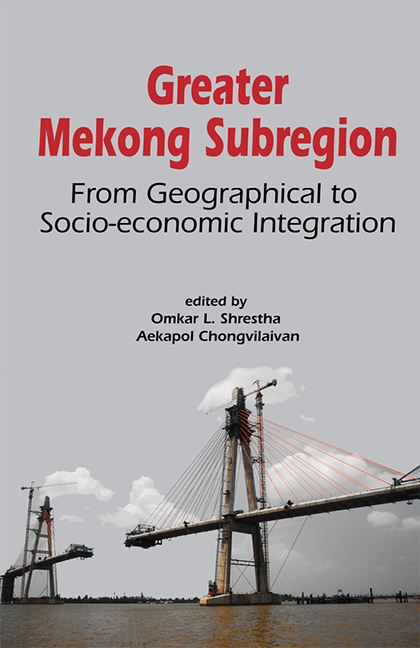Book contents
- Frontmatter
- Contents
- Preface
- List of Abbreviations
- Contributors
- 1 Greater Mekong Subregion: From Geographical Corridors to Socio-economic Corridors
- 2 Cambodia, Its Development, and Integration into the GMS: A Work in Progress
- 3 Subregional Connectivity in the Lao PDR: From Land-locked Disadvantage to Land-linked Advantage
- 4 The Economic Development of Myanmar and the Relevance of the Greater Mekong Subregion
- 5 GMS Challenges for Thailand
- 6 Deepening GMS Cooperation in a More Integrated ASEAN and East Asia
- 7 China (Yunnan)–GMS Economic Cooperation: New Development and New Problems
- 8 Trade and Investment in the Greater Mekong Subregion: Remaining Challenges and the Unfinished Policy Agenda
- 9 Enhancing Financial Cooperation among the GMS Countries
- 10 The Challenges of GMS Regional Integration: Case Study of Governance of the Logistics Industry in Thailand
- 11 Energy Sector Integration for Low-carbon Development in the GMS: Towards a Model of South-South Cooperation
- 12 Linking the Social to the Economic: Broadened Ambitions and Multiple Mitigations in New Mekong Corridors
- Index
8 - Trade and Investment in the Greater Mekong Subregion: Remaining Challenges and the Unfinished Policy Agenda
Published online by Cambridge University Press: 21 October 2015
- Frontmatter
- Contents
- Preface
- List of Abbreviations
- Contributors
- 1 Greater Mekong Subregion: From Geographical Corridors to Socio-economic Corridors
- 2 Cambodia, Its Development, and Integration into the GMS: A Work in Progress
- 3 Subregional Connectivity in the Lao PDR: From Land-locked Disadvantage to Land-linked Advantage
- 4 The Economic Development of Myanmar and the Relevance of the Greater Mekong Subregion
- 5 GMS Challenges for Thailand
- 6 Deepening GMS Cooperation in a More Integrated ASEAN and East Asia
- 7 China (Yunnan)–GMS Economic Cooperation: New Development and New Problems
- 8 Trade and Investment in the Greater Mekong Subregion: Remaining Challenges and the Unfinished Policy Agenda
- 9 Enhancing Financial Cooperation among the GMS Countries
- 10 The Challenges of GMS Regional Integration: Case Study of Governance of the Logistics Industry in Thailand
- 11 Energy Sector Integration for Low-carbon Development in the GMS: Towards a Model of South-South Cooperation
- 12 Linking the Social to the Economic: Broadened Ambitions and Multiple Mitigations in New Mekong Corridors
- Index
Summary
The Greater Mekong Subregion (GMS) is often described as one of the most successful stories of economic transition and integration among developing countries. For much of the 1970s and early 1980s, while the rest of Asia was busy growing and integrating with the global economy, the GMS remained extremely poor and isolated — the outcome of years of conflict and central planning in Cambodia, the Lao People's Democratic Republic (Lao PDR), Myanmar, and Vietnam (CLMV). Beginning in the mid-1980s, however, these countries began a gradual process of reform and liberalization.
The CLMV countries’ transition towards a market-based system has allowed the GMS to reinvent itself as one of the most dynamic subregions in the world. In the last twenty years, the GMS has grown at a faster pace than the whole of developing East Asia and the Pacific, with much of this growth coming from the CLMV countries. While Thailand and the rest of Asia reeled from the impact of the 1997/98 Asian financial crisis, the CLMV countries continued to post positive growth, given their limited connection to global financial markets at the time (Figure 8.1). While these countries were not as immune to the more recent global financial crisis (GFC), with sharp drops in growth that have begun to reverse only recently, this underlies a decade of growing openness and integration with the global economy. The sustained economic growth leading up to the GFC has been accompanied by a gradual shift away from agriculture, which has traditionally accounted for the biggest share of value added in the CLMV countries. Across the subregion, industry, manufacturing, and services now account for a bigger share of value added (Table 8.1).
This economic progress has translated into marked improvements in human development outcomes across the subregion (Table 8.2). GDP per capita in constant 2000 U.S. dollars has more than doubled in Cambodia, Lao PDR, and Vietnam since the early 1990s. Infant mortality rates have declined rapidly in the last fifteen years, while literacy rates have shown gradual improvements since the beginning of the decade. Perhaps more importantly, poverty rates (that is, the poverty headcount ratio at $1.25 a day, PPP) have fallen dramatically across the subregion.
- Type
- Chapter
- Information
- Greater Mekong SubregionFrom Geographical to Socio-economic Integration, pp. 119 - 161Publisher: ISEAS–Yusof Ishak InstitutePrint publication year: 2013

